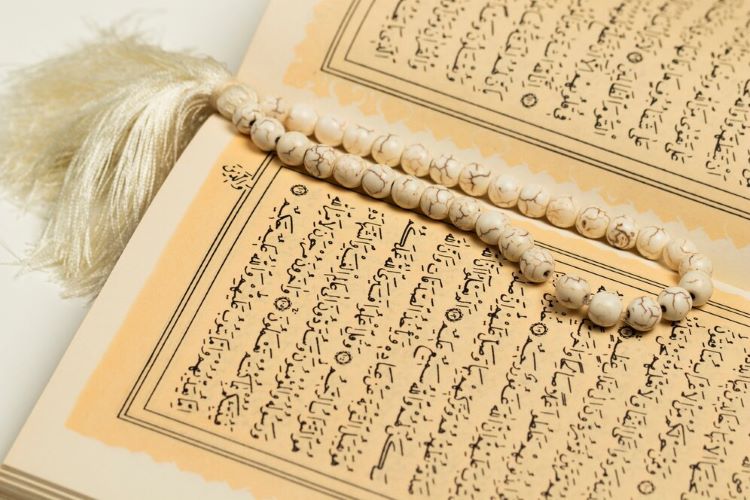Discover how The Rules and Stop Signs in Quran can enhance your recitation. Uncover these guiding markers and learn how they can transform your understanding and deepen your connection to the sacred text.
The Quran, revealed by Allah (SWT) to Prophet Muhammad (PBUH) through Angel Jibreel, serves as a guide for Muslims.
To fully appreciate its message and gain Allah’s (SWT) pleasure, proper recitation is essential.
This involves recognizing the markings above certain words. These symbols are not merely decorative; they are waqf in quran, a system designed to guide pauses, stops, and continuations during recitation.
Mastering these Waqf rules and stop signs in the Quran will enhance your Quran reading, allowing you to grasp the deeper meaning within the verses.
By following these quran stop signs, you’ll ensure accurate and meaningful recitation.
Table of Contents
ToggleWhat are the stop signs in the Quran?
Signs in the Quran, also known as waqf in quran or stopping signs, are symbols that guide the reader on where to pause, stop, or continue reciting. These signs are carefully placed and are not random; they play a crucial role in preserving the intended meaning of the verses. Their placement reflects centuries of meticulous scholarship, ensuring that every recitation of the Quran remains accurate and faithful.
Beginners can start with learn Quran online to understand these basics, while learners refining pronunciation may join a learn Quran online with Tajweed course. Students focusing on recitation can benefit from an online Quran recitation with Tajweed program, and those aiming to memorize may enroll in an online hifz program. For additional tips on expressive and accurate recitation, explore how to recite the Quran beautifully.
Following these signs correctly ensures that every recitation preserves the intended meaning of the verses while adhering to traditional Tajweed rules.
Stop Symbols in Quran Meaning
In addition to fundamental Tajweed rules such as those concerning Meem Sakinah, Laam Sakinah, Laam Shamsiya, and Qamariya, scholars have introduced symbols and rules of pausing in Quran recitation.
These aids, mentioned earlier, assist the reciter in pausing at points that convey the intended meaning accurately. Understanding these Quran symbols’ meaning is crucial.
Every starting or stopping point is categorized as permissible, prohibited, or unsuitable based on its impact on the completeness and correctness of the meaning.
We have endeavored to compile the most prevalent Quran symbols’ meaning and rules, even in Urdu Mushafs, as follows:

What Are The Stop Signs in the Quran with Examples?
A Guide to quran stop signs (Waqf)
The Quran, a sacred text for Muslims, holds immense wisdom and guidance.
To fully grasp its meaning and beauty, proper recitation is crucial. This includes understanding the system of stopping signs, known as Waqf. These symbols, found above some words in the Quranic script, guide pauses, continuations, and stopping points during recitation.
Here’s a breakdown of the stop sign quran With Examples
waqf in quran:
- م (Mudd):
- Compulsory Stop
- Indicates a mandatory pause to avoid altering the meaning of the verse.
- Signifies a clear stopping point.
Example: “فَاتَّقُوا النَّارَ الَّتِي وَقُودُهَا النَّاسُ وَالْحِجَارَةُ ۖ أُعِدَّتْ لِلْكَافِرِينَ” (Surah Al-Baqarah 2:24) Explanation: The stop at “النَّاسُ” is mandatory to avoid changing the meaning.
- ط (Mutlaq):
- Normal Stop
- Suggests a natural stopping point, often at the end of a sentence or thought.
Example: “وَأَقِيمُوا الصَّلَاةَ وَآتُوا الزَّكَاةَ ۚ” (Surah Al-Baqarah 2:43)
Explanation: It’s natural to stop at “الزَّكَاةَ” as it concludes a sentence.
- ج (جائز):
- Permissible Stop
- Allows for a pause, but continuing recitation is also acceptable.
- Signifies a sufficient stopping point.
Example: “إِنَّمَا الْمُؤْمِنُونَ إِخْوَةٌ ۚ” (Surah Al-Hujurat 49:10)
Explanation: Stopping at “إِخْوَةٌ” is sufficient, but continuing is acceptable.
- صلى (Seli) or (Zajr):
- Permissible Stop (Preferable to Continue)
- Indicates a permissible pause, but continuing the recitation without stopping is preferable.
- Signifies a good stopping point.
Example: “فَإِنَّ مَعَ الْعُسْرِ يُسْرًا” (Surah Ash-Sharh 94:6)
Explanation: Stopping at “الْعُسْرِ” is permissible, but it’s better to continue.
- قلي (Qali):
- Permissible to Continue (Preferable to Stop)
- Allows for continuing recitation, but stopping is preferable.
- Can indicate a complete or sufficient stopping point depending on the context.
Example: “قُلْ هُوَ اللَّهُ أَحَدٌ” (Surah Al-Ikhlas 112:1)
Explanation: Continuing is allowed, but stopping after “أَحَدٌ” is preferable.
- لا (Laa):
- Repulsive Stop
- Signifies that recitation should not be cut off or stopped at the marked word.
- Important to continue the recitation smoothly without pausing.
Example: “يَا أَيُّهَا الَّذِينَ آمَنُوا لَا تَتَّبِعُوا خُطُوَاتِ الشَّيْطَانِ ۚ” (Surah An-Nur 24:21) Explanation: One should not stop at “آمَنُوا” to avoid disrupting the message.
- قف (وقف – Waqf):
- The Anticipation Mark
- Indicates a preferable stopping point, but continuing is also permissible.
Example: “وَرَتِّلِ الْقُرْآنَ تَرْتِيلًا” (Surah Al-Muzzammil 73:4)
Explanation: Stopping at “الْقُرْآنَ” is preferable, but continuing is also permissible.
- ∴ (Mutanā’iqah):
- The Embracing Stop
- Appears on two words within a verse.
- If you choose to stop on one word, you cannot stop on the other.
- Continuing without stopping on either word is also allowed.
Example: “وَلَا تَقْتُلُوا أَنفُسَكُمْ إِنَّ اللَّهَ كَانَ بِكُمْ رَحِيمًا” (Surah An-Nisa 4:29)
Explanation: You can stop at “أَنفُسَكُمْ” or “بِكُمْ”, but not both. Continuing without stopping on either is also an option.
This was the answer to what are the stop signs in the quran.
Mastering these Waqf signs will significantly enhance your Quran recitation, helping you understand the appropriate pauses and stopping points, and unlocking deeper layers of meaning within the verses.
How Many Stops are There in The Quran?
There is no fixed total number of stops in the Quran.
Instead, the Quran contains hundreds of stop signs spread throughout the Mushaf, and these symbols repeat many times.
However, what is fixed is the types of stop signs, and there are 8 main types used in the Medina Mushaf.
The Benefits of Following Quran Stop Rules
Observing the stopping rules in the Quran goes beyond correct recitation; it brings numerous spiritual and practical benefits:
- Preserving the Original Meaning: The Quran was revealed within a precise linguistic and contextual framework. quran stop signs help maintain this context, ensuring that the meaning of the verses is not unintentionally altered.
- Enhancing Spiritual Reflection: Pausing at the right moments allows for deeper contemplation and understanding, giving the reader time to reflect on the divine message and its relevance to daily life.
- Improving Tajweed: Tajweed, the science of Quranic pronunciation, is closely tied to stopping rules. Applying these rules enhances the quality of recitation, making it more accurate and melodious.
- Facilitating Memorization: Correct pauses help divide verses into manageable sections, simplifying the process of memorizing the Quran.
- Strengthening Connection with Allah: Proper recitation is a form of worship. Following the stop rules allows readers to engage more deeply with the Quran, fostering a stronger spiritual bond with Allah.
Embark on a transformative journey of Quranic learning with Madrasah El-Quran’s state-of-the-art Tajweed courses.
Our online platform offers an authentic and engaging Tajweed learning experience, bringing the timeless beauty of Quranic recitation to learners around the world.

Why Choose Madrasat El-Quran for Tajweed Learning?
Expert Guidance from Qualified Instructors
Learn from experienced Tajweed instructors dedicated to teaching the art of pristine Quranic recitation.
Structured and Comprehensive Curriculum
Follow a structured curriculum that covers fundamental Tajweed rules, pronunciation nuances, and advanced recitation techniques. Enrolling in online Quran classes with Tajweed ensures you receive comprehensive guidance to master each aspect of proper Quranic recitation.
Engaging and Interactive Lessons
Benefit from dynamic lessons featuring video tutorials, audio recordings, and interactive exercises to enhance your Tajweed skills.
Real-Time Support with Live Sessions
Join live sessions with our scholars for real-time guidance, personalized feedback, and interaction with a supportive learning community.
Flexible Learning Anytime, Anywhere
Enjoy the convenience of learning Tajweed at your own pace, fitting seamlessly into your schedule, from the comfort of your home.
Access to Extensive Resources
Utilize a wealth of Tajweed resources, including practice materials, quizzes, and additional learning aids to deepen your understanding.
Authentic Quranic Recitation Experience
Immerse yourself in the authentic recitation of the Quran with tajweed, refining your skills to recite with precision, melody, and a profound connection to the divine text.
In summary, mastering Tajweed symbols and rules ensures accurate and meaningful engagement with the Quran, enhancing both pronunciation and spiritual connection.
Conclusion
In conclusion, be patient and mindful as you read and learn the Quran. Understanding and applying the stop signs in Quran is essential for accurate recitation and preserving the intended meaning of the verses. Remember, improvement is a journey dedication to learning and practicing tajweed, including online lessons, will help you recite with confidence and deepen your connection with Allah. By paying attention to the correct stopping points, you not only enhance your recitation but also enrich your spiritual reflection and understanding of the Quran’s divine message.
With Madrasat El-Quran, you can now enroll in an online tajweed course with certificate and learn all the Tajweed rules, including the rules for stopping when reading the Quran.
FAQ About Stop Signs in Quran
What do stop signs in the Quran mean?
indicate the proper moments to pause, reflect, and contemplate the divine message.
What is the full stop symbol in the Quran?
The letter ﻃ (mutlaq) signifies a full stop.

Madraset El Quran Academy
Madraset Elquran Academy is a world-class platform for learning Quran, Arabic, and Islamic Studies, recognized globally for its excellence. As one of the leading online Quran schools, we offer personalized one-on-one sessions with expert native Egyptian tutors, providing high-quality education for learners of all levels.



